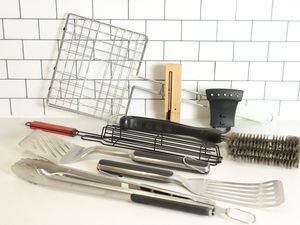
The Spruce Eats / Russell Kilgore
It's officially too hot to cook inside, and grilling outside always leads to a great flavorful meal with minimal prep—plus, you usually get to have fun while doing it. After testing more than 80 grills in the past year, we’ve fine-tuned our grill requirements. Our favorites not only perform exceptionally well, they also are easy to use, very durable, and simple to maintain.
During our tests to find the best grills, we also pay attention to heat retention and temperature control, so you can run back into the kitchen and not worry about your food being undercooked. Pros will appreciate all the features we’ve highlighted, but even if you’re new to grilling, there’s a grill here for you.
Best Overall, Gas
Weber Genesis EX-325S Smart Gas Grill
Top-of-the-line performance
Very spacious grilling area
Easy to control temperature
Great, durable grill for any skill level
Expensive
Can’t control burners from app
When we tested gas grills side-by-side, we didn’t expect a smart grill to take the top spot. But after two weeks of testing, it outperformed all the rest including its basic counterpart!
It wasn’t just the Weber Genesis EX-325s’s smart technology that won us over—the grill’s performance and design are nearly unparalleled. The 39,000 BTUs under the 513-square-inch main cooking grate flawlessly grilled our burgers and steaks. The only slight hiccups were a small flare-up while lightly oiling the grate pre-vegetables, and the areas directly above the burners being warmer than anywhere else.
Throughout all of our grilling, we enjoyed using the digital control panel, which connects to two included probe thermometers. This connects into the Weber smartphone app, which can give you temperature alerts in addition to its recipes and maintenance guides. Our phones stayed connected to the app for about 30 yards, and overall we enjoyed the added convenience. We just wished we were able to control the burners via the app instead of walking back and forth.
In the end, there's a reason there are (spoiler!) many Weber grills on this list. We've tested many in our testing lab, but have also seared and cooked on some in the homes of some of our experienced home testers. An older Weber model that doesn't have any smart features, but has been a solid performer for many years. When it’s blazing hot in the summer and we don’t want to heat up the kitchen, we know that we can turn a knob to fire up the gas, and cook a single steak or a few cheeseburgers just as fast—or faster—than we could cook the same thing in the kitchen.
Dimensions: 61.5 x 27 x 48.5 inches | Cooking Area: 787 square inches | Burners: 3 | Power: 39,000 BTUs/hour | Warranty: 3 years (Weber Connect); 10 years (cooking grates, burner tubes, Flavorizer bars); 12 years (lid, cookbox); 5 years (all other parts)
![Weber Genesis EX-325S Propane Gas Smart Grill displayed on a patio]()
PHOTO: The Spruce Eats / Russell Kilgore ![Closeup of the temperature display of the Weber Genesis EX-325S Propane Gas Smart Grill]()
PHOTO: The Spruce Eats / Russell Kilgore ![Person cooking burger patties on the Weber Genesis EX-325S Propane Gas Smart Grill]()
PHOTO: The Spruce Eats / Russell Kilgore ![Grill utensils hanging on hooks on the side of the Weber Genesis EX-325S Propane Gas Smart Grill]()
PHOTO: The Spruce Eats / Russell Kilgore ![Halved grilled meat patties arranged on a baking sheet]()
PHOTO: The Spruce Eats / Russell Kilgore ![Hand lifting a component out of the Weber Genesis EX-325S Propane Gas Smart Grill]()
PHOTO: The Spruce Eats / Russell Kilgore ![Dirty grill grate on the Weber Genesis EX-325S Propane Gas Smart Grill]()
PHOTO: The Spruce Eats / Russell Kilgore
Best Overall, Charcoal
Weber Performer Deluxe Charcoal Grill
Large prep area and storage
Gas ignition system
Easy to adjust dampers
Hard to adjust coals
As much as we love charcoal grills, they aren’t without their faults. They can be especially tedious to light, messy to clean, and your barbecue plans can be ruined if the bag of charcoal gets wet. Safeguards against all of these issues is at the heart of why we love the Weber Performer Deluxe. Add to that its sublime performance, and this is a grill to have on your back patio.
Its performance truly impressed us during an hours-long test where we smoked a full rack of baby back ribs, and not once did the temperature fluctuate wildly. In fact, it stayed within a 10-degree range the whole time, with the built-in thermometer running a little hotter than our infrared thermometer readings. Adjusting the temperature was simple, when needed, as the dampers and vents are easy to move.
Needing to add charcoal during such a long cooking session is where one of the only downsides appeared—it is difficult to adjust coals via the circular opening in the grate. Otherwise, the gas ignition system made lighting up the coals effortless and the cleaning system was a boon. We also appreciated the extra-long side prep table and charcoal storage underneath.
Dimensions: 48 x 30 x 44.1 inches | Cooking Area: 363 square inches | Warranty: 5 years (cleaning system, plastic components), 10 years (bowl, lid); 2 years (all other parts)
![Hands holding grate above charcoals on the Weber Performer Deluxe]()
PHOTO: The Spruce Eats / Russell Kilgore ![Hand adjusting timer on the Weber Performer Deluxe]()
PHOTO: The Spruce Eats / Russell Kilgore ![Hand with tongs placing grate above charcoals on the Weber Performer Deluxe]()
PHOTO: The Spruce Eats / Russell Kilgore ![Hand using thermometer to measure heat on the Weber Performer Deluxe]()
PHOTO: The Spruce Eats / Russell Kilgore ![Hand placing grate above charcoals on the Weber Performer Deluxe]()
PHOTO: The Spruce Eats / Russell Kilgore ![The Weber Performer Deluxe Charcoal Grill on grass near wooden fence]()
PHOTO: The Spruce Eats / Russell Kilgore
Best Budget
Weber Original Kettle Premium Charcoal Grill
Classic, compact design
Tried-and-true cooker
Great for beginners
Smaller cooking area
Built-in thermometer can be inaccurate
If you want an inexpensive standalone grill, it’s more economical to choose a charcoal model since there isn’t the electronics necessary for a gas or pellet grill. But when it comes to a budget grill, you should go with the best, an iconic Weber Original kettle-style grill. Since this doesn’t have all the bells and whistles, it’s very intuitive to use and takes less than 15 minutes to put together.
We’ve tested it out twice now, and once you get the hang of positioning the dampers correctly, even a true beginner can handle grilling a fantastic meal. The porcelain-coated lid and bowl do retain significant heat inside the grill, but we have noticed that the built-in thermometer can oftentimes have an inaccurate reading. Be sure to have a separate thermometer on-hand to grill your burgers and hot dogs to the right temperature.
Dimensions: 27 x 22 x 39.5 inches | Cooking Area: 363 square inches | Warranty: 10 years (bowl and lid); 5 years (cleaning system and plastic components); 2 years (everything else)
![Weber Original Kettle Premium 22-Inch Charcoal Grill on grass in a backyard]()
PHOTO: The Spruce Eats / Russell Kilgore ![person flipping meat on a Weber Original Kettle Premium 22-Inch Charcoal Grill]()
PHOTO: The Spruce Eats / Russell Kilgore ![someone pouring coal into a Weber Original Kettle Premium 22-Inch Charcoal Grill]()
PHOTO: The Spruce Eats / Russell Kilgore ![Hands pouring hot coals into a Weber Original Kettle Premium 22-Inch Charcoal Grill]()
PHOTO: The Spruce Eats / Russell Kilgore ![Closeup of the temperature gauge on a Weber Original Kettle Premium 22-Inch Charcoal Grill]()
PHOTO: The Spruce Eats / Russell Kilgore
Best Portable
Weber Traveler Portable Gas Grill
Unique fold-flat design
Large cooking surface
Accurate built-in thermometer
Expensive
Uneven heating, especially with lid open
Difficult to clean
Portable grills can sometimes bring to mind mini versions of kettle grills or barrel smokers, but after testing portable grills for a month, this collapsible Weber portable gas grill was one of the best. Yes, we thoroughly enjoyed collapsing it down and wheeling it into position, instead of having to carry a grill and/or its parts long distances.
We also really enjoyed its performance. Once you hook up the gas—this can use a 1-pound canister or a 20-pound tank—you’ll be able to get temperatures of up to 660 degrees, high enough to sear steak or make a crispy pizza. Additionally, you won’t need to carry along an extra thermometer since the built-in thermometer gives an accurate reading, as we observed during testing. If you plan on taking this camping and grilling at night, you may want to buy a grill light to attach as needed.
We did notice some uneven heating across the 320-square-inch grate when we left the lid open. This tended to resolve itself when we closed the lid, but it’s something to keep in mind. There was also some elbow grease required during cleanup.
Dimensions: 42.7 x 43.6 x 37.2 inches | Cooking Area: 320 square inches | Power: 13,000 BTU/hour | Weight: 49 pounds
![Weber Traveler Portable Gas Grill with food being grilled in backyard]()
PHOTO: The Spruce Eats / Russell Kilgore ![person using Weber Traveler Portable Gas Grill in backyard]()
PHOTO: The Spruce Eats / Russell Kilgore ![person's hand using Weber Traveler Portable Gas Grill]()
PHOTO: The Spruce Eats / Russell Kilgore
Best with Smoker
PK Grills Original PK300 Grill and Smoker
Easy setup
Excellent heat retention and control
Great for tailgating
Built-in side table
Learning curve with venting system
No built-in thermometer
If you truly want a different type of grill, and something somewhat versatile, the PK Grills PK300 is the answer. This unique grill allows you to do both direct and indirect heat, and also disconnects from the base to be used as a portable grill. We’ve tested both the original version and this "new original" model, and highly recommend both.
The PK300 works great partly due to its cast-aluminum body, an ideal material for heat retention, and partly due to a four-vent system (two dampers and two vents). These allow you to get high temperatures for grilling, while also allowing great airflow for low-and-slow smoking.
On the new version, some of the design updates include a tighter-fitting lid, longer handles on the vents, and an opening for a probe thermometer. It did not include a built-in thermometer, and since this can get very hot, very quickly, you should have a probe or instant-read thermometer nearby. We accidentally over-charred a steak while testing, and even with that mishap, this is been one of the best grills we’ve ever tested.
Dimensions: 42.75 x 16.2 x 37.35 inches | Cooking Area: 315 square inches | Warranty: 20 years (aluminum bowl, lid) 3 years (stainless steel grates); 3 years (plastic components); 2 years (all other metal parts)
![A PK Grills PKGo Camp & Tailgate Grilling System in a yard]()
PHOTO: The Spruce Eats / Russell Kilgore ![A person grilling on the PK Grills PKGo Camp & Tailgate Grilling System]()
PHOTO: The Spruce Eats / Russell Kilgore ![Closeup of a opening the lid on the PK Grills PKGo Camp & Tailgate Grilling System]()
PHOTO: The Spruce Eats / Russell Kilgore ![A steak with a temperature probe sitting on a PK Grills PKGo Camp & Tailgate Grilling System]()
PHOTO: The Spruce Eats / Russell Kilgore ![Closeup of a hand moving the smoke vent on the PK Grills PKGo Camp & Tailgate Grilling System]()
PHOTO: The Spruce Eats / Russell Kilgore ![The Original PK Grill & Smoker]()
PHOTO: The Spruce Eats / Sarah Vanbuskirk ![The Original PK Grill & Smoker]()
PHOTO: The Spruce Eats / Sarah Vanbuskirk ![The Original PK Grill & Smoker]()
PHOTO: The Spruce Eats / Sarah Vanbuskirk ![The Original PK Grill & Smoker]()
PHOTO: The Spruce Eats / Sarah Vanbuskirk ![The Original PK Grill & Smoker]()
PHOTO: The Spruce Eats / Sarah Vanbuskirk
Digital controls, plus an app
Excellent performance
Self-cleaning
Easy to light and clean
Expensive
Heavy
Grill cart needs assembly
Over the past decade, grills, like every other major appliance, have started integrating smart technology into the cooking process, with the one exception being kamado grills. That was until the Konnected Joe debuted this year! It quickly surpassed other kamados since it removed the learning curve (and made maintaining a kamado easier, too).
Since kamados cook with charcoal, you usually still have to deal with the lighting process, but not here. The Konnected Joe has a push-button start; here, a heating element inside the grill gets the charcoal lit for you. The grill then takes over for getting to and maintaining the right temperature. We’ve tested this grill twice already, and it was able to keep a consistent temperature throughout an entire hours-long smoking session without us having to touch a thing.
The digital controls are what make the consistency possible. You literally set it and forget it, except when you open the app to see the temperature graph. Whether we were grilling ribs, smoking brisket, or using this as a rotisserie—it is compatible with current Kamado Joe accessories—we were blown away by the excellent results (and the self-cleaning feature after).
After testing this one in the lab and at home, we have to admit we are huge fans. It has everything we love about cooking over lump charcoal, but none of the pain of managing temperatures. We don’t always use the heat management features, like when we're cooking burgers, but it’s nice to know that we can roast a chicken without worrying about turning it into a cinder. We look forward to firing up this grill every year, as soon as the weather allows.
Dimensions: 47 x 31 x 48 inches | Cooking Area: 250 square inches | Temperature Range: 225 to 700 degrees Fahrenheit
![A temperature reading on a Kamado Konnected Joe grill]()
PHOTO: The Spruce Eats / Donna Currie ![A Kamado Konnected Joe grill in a yard]()
PHOTO: The Spruce Eats / Donna Currie ![Ribs cooking on a Kamado Konnected Joe grill]()
PHOTO: The Spruce Eats / Donna Currie ![A person pulling out coals on a Kamado Konnected Joe grill]()
PHOTO: The Spruce Eats / Donna Currie ![The inside of the Kamado Joe Konnected Joe 18-Inch Digital Charcoal Grill and Smoker before use]()
PHOTO: The Spruce Eats / Donna Currie ![The front of the Kamado Joe Konnected Joe 18-Inch Digital Charcoal Grill and Smoker showing the digital display]()
PHOTO: The Spruce Eats / Donna Currie ![The Kamado Joe Konnected Joe 18-Inch Digital Charcoal Grill and Smoker outside on a patio]()
PHOTO: The Spruce Eats / Donna Currie
Final Verdict
Even though it’s a bit of an investment, the Weber Genesis EX-325s Smart Gas Grill will continue to perform great for a number of seasons. For those who still want to have a smoky backyard haze, we like the spacious grilling area and intuitiveness of the Weber Performer Deluxe Charcoal Grill.

The Spruce Eats / Russell Kilgore
How We Tested Grills
We test grills year-round, with many of our winners undergoing extensive testing with our experts in their everyday lives—at real tailgates, camping trips, and at home—so that we can update our recommendations and insights on long-term usability and more on a regular basis. Over the past year, we’ve also tested 99 grills in our Lab, cooking up everything from flank steaks to onions to slices of white bread, which can accurately assess how even the heat is across your grill grate.
We’ve also interviewed grilling experts to get their insights on what are the most important elements of successful grilling. During testing, we assemble each grill ourselves, paying special attention to timing and ease of assembly; analyze every facet of the grilling process; and clean the grill afterward. To date, we’ve grilled:
- 200 pounds of chicken wings
- 80 pounds of hamburger
- 63 pounds of flank steak
- 50 pounds of baby back ribs
- 46 chicken breasts
- 40 pounds of bone-in ribeye
- 15 pounds of bratwurst
- 10 pounds of strip steak
- 10 pounds of snapper
- 50 pounds of yellow onions
We Observed
- There are a lot of choices. Charcoal grills come in a wide range of sizes, styles, prices, and complexities. While it’s possible to grill food on a rusty grate over a coffee can, unless you’re on a survival mission, it’s best to opt for something better. How much better is up to you.
- Design can matter. Some features make grills easier to use, while sturdiness is also important. A heavy lid keeps heat in, but can be difficult for some cooks to wrangle on their own.
- Cooking style and experience matter. If the cook plans on grilling burgers and brats all summer, a high-end grill will be a waste of space and money. An experienced cook who is practicing for competition cooking will have entirely different needs.
- Cleaning is a part of cooking. If the grill is difficult to clean, the ashtray is difficult to access, and food always sticks, the grill will get less use than one that’s simple to maintain.
We Rated
- Ease of Use: Let’s face it, if a grill is difficult to use, cooking can become a chore.
- Design/Features: Some cooks will love wireless control and apps, while others want something much simpler. The size and shape of the grill also matter, depending on what’s being cooked. It’s simple to line up rows of sausages on any grill, but slabs of ribs or whole turkeys aren’t as easy to fit.
- Performance: Of course, performance matters. It doesn’t matter how pretty the grill is, if the food cooks inconsistently, or worse yet if it can’t produce the grill marks or sear you’re looking for.
- Ease of Cleaning: While most grills manage to burn off food debris from the grates, the location and ease of emptying the ash and grease are also a consideration.
- Value: While it’s often true that you get what you pay for, no one wants to overpay for what they’re getting. If the extra features won’t be used, there’s no need to buy the highest-priced model to get those extras.
The Spruce Eats Team Tests Gas Grills
Long-Term Testing Takeaways
After all of our different tests that have spanned several years, we have to admit that there is no single grill that’s perfect for every person. But the good news is that there’s a vast array of grills to choose from.
The newest grills are getting smart, with digital controls, automatic heat regulation, and apps. While some of us love digital controls, there’s nothing wrong with opting for grills that are manual only.
For any grill, precise heat control is most important for long cooks. Quickly grilling burgers and hot dogs doesn’t require nearly as much finesse.
What to Look for in a Grill
Fuel Type
Grill categories are broken down by fuel type: gas, charcoal, or wood pellets. Gas grills—both liquid propane and natural gas—are as easy as using a stove. You simply turn the knobs to control the burners, and shut it off when you’re done. There is some regular maintenance needed, like cleaning the grill grate or washing out the grease pan. The tradeoff is your food won’t get the smoky flavor imparted by charcoal or wood.
Charcoal grills tend to be cheaper than gas models, but they require more effort for cooking. You need to learn how to get the charcoal to catch flame and how to properly place them in the grill. "With a kettle-style charcoal grill, I almost always place lit coals on one side and leave the other side without coals," says Christie Vanover, the publisher of Girls Can Grill. "This allows me to cook food over high heat (over the coals) when I want to sear the meat or veggies and over medium or low heat when I want to smoke the food or cook it more slowly." You’ll also have to wait for the coals to cool before being able to clean up. As with all grills, you’ll need to deep clean to keep the grill cooking, but the assembly is fairly simple.
Pellet grills use wood “pellets” that are fed from a hopper into the grill. This is great for smoking foods at low temperatures, since the pellets give off a consistent heat and a full hopper usually lasts for hours. They give your food a wonderful smoky flavor. But pellet grills are definitely more expensive than other types, and there are more parts that could break if not maintained properly. They also generally require power to run the automatic feed, which means the grill will need to be placed near an outlet.

The Spruce Eats / Russell Kilgore
Capacity
What size grill you need does really come down to how many servings you need to cook at a time. For most households, a grill with a cooking area of under 500 square inches is more than enough for weekday dinners and weekend get-togethers. If you regularly cook for a crowd, or have a larger household, getting a grill with more than 500 square inches of space should be a priority.
Maintenance
All grills need regular cleaning and maintenance to operate properly. "It’s best to do a deep clean at least once a year," says Vanover. "The best time is right before winter, so it’s fresh and clean for the spring. If you live in a climate where you grill year-round, consider doing a deep clean every six months.
"Gas grills are the hardest to deep clean, because it involves taking out the grates and burners," she says. "Charcoal grills are the easiest to clean because they have very few components."
At the very least, you should clean your grill grates after cooking to remove stuck-on food and grease. It’s advisable to thoroughly clean your grill a few times every year to remove any grease inside the grill whether that’s a drip pan or simply wiping down the inside of the grill bowl. Additionally, using a grill cover will help protect the exterior from any corrosion.

The Spruce Eats / Russell Kilgore
FAQs
What are the best rules for grilling?
For grilling safety, definitely clean your grill and grill away from your house. Preheating is also good to do, and don’t turn on the gas when the lid is closed. When it comes to food safety, a good rule is to keep your meats separate from other foods before cooking. This will protect against any cross-contamination.
"My number one rule for grilling is to cook food to temperature, not time," says Vanover. "The USDA has set internal temperature suggestions for every protein. These recommendations not only ensure the meat is fully cooked and safe to eat, but they are also set to ensure the meat is at its peak point for flavor and juiciness.
"Another rule that’s important is to wait to sauce your meat until after it’s almost fully cooked," she says. "Sauce usually has a lot of sugar. If you add sauce too early, it will burn before the meat is fully cooked. If you want to add flavor earlier in the cooking process, consider a good rub or a marinade."
What are the methods of grilling?
You can grill either with direct heat or indirect heat. Direct heat is placing your food directly above the flame. Direct heat is desirable for high heat and getting a great sear. Indirect heat is when the food is off to the side of the flame. It’s very important to position your vents correctly so that the air flows over your food. Indirect heat is more often used at lower temperatures, for longer periods of time, with larger cuts of meat, and/or for smoking.

The Spruce Eats / Russell Kilgore
What are the big differences between a gas grill and a charcoal grill?
Besides the obvious fuel differences, gas grill have a higher upfront cost while charcoal grills are often on the inexpensive side. Gas grills will be a faster preparation since you don’t have to preheat or wait for the coals to cool. Charcoal grills will impart more flavor into your food, and you have more fun with the experimental aspect of cooking with them.
Why Trust The Spruce Eats?
The Spruce Eats Editor Siobhan Wallace compiled testing data from our official Lab to compile this roundup. Her mother once left the gas grill lid closed with the gas on and saw the resulting fireball.
Expert product tester and writer Donna Currie also updated this story with insights into several grills she owns and has been using for years as well as tips and tricks she has learned while flipping, charring, and smoking in her backyard.
















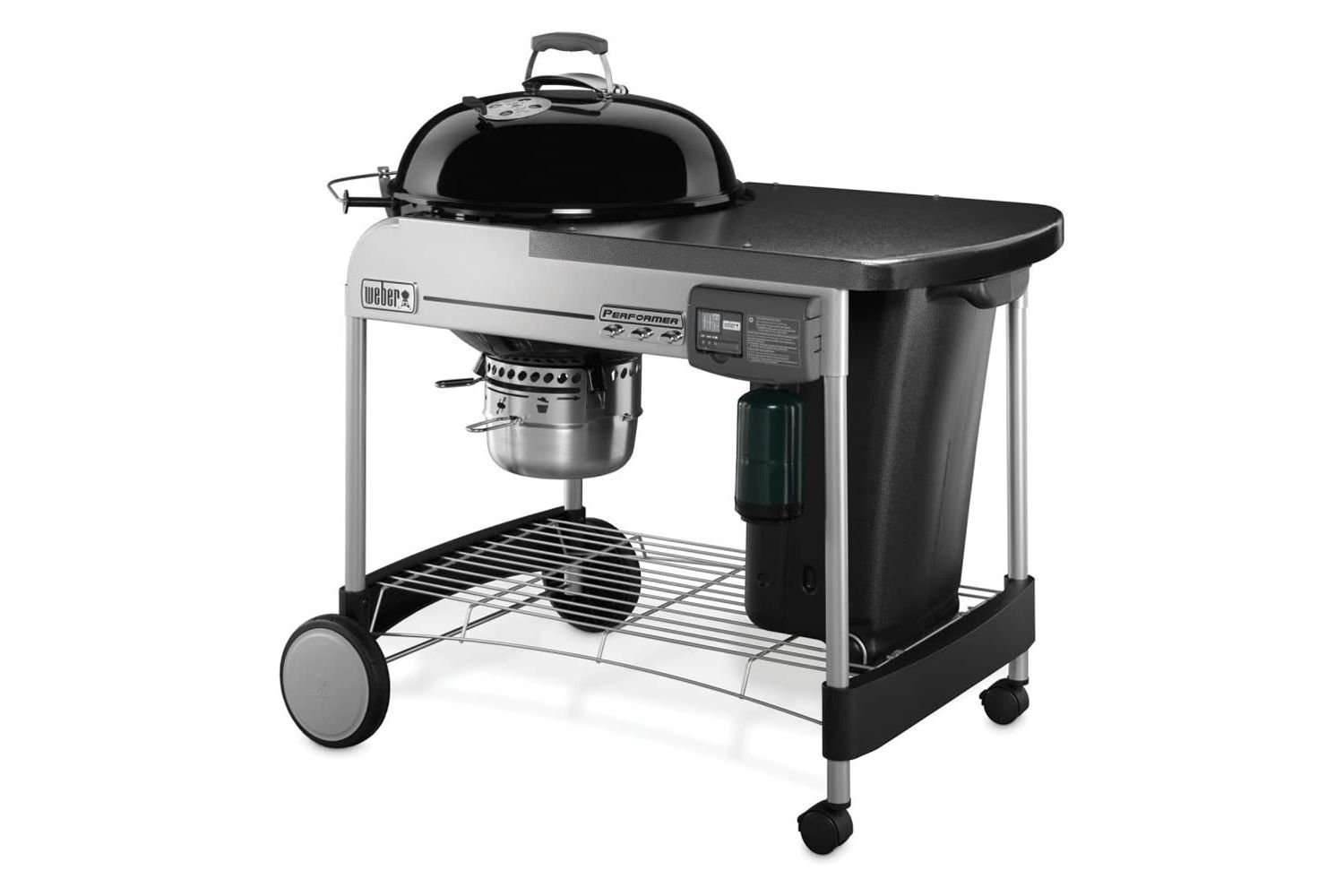


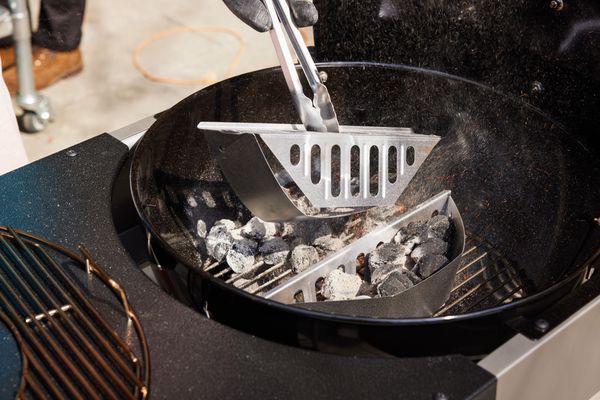











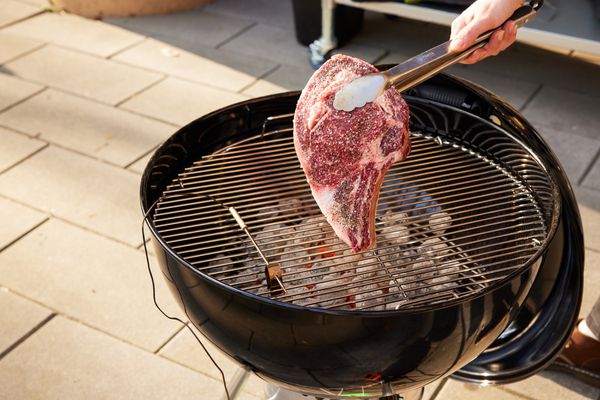










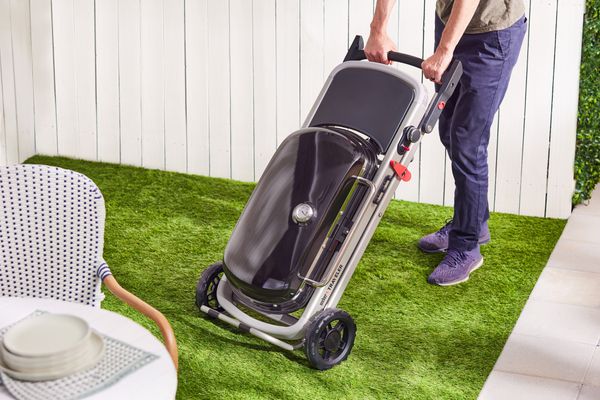




:max_bytes(150000):strip_icc()/pk-grills-charcoal-bbq-grill-and-smoker-pk300-bcx-cast-aluminum-portable-outdoor-barbeque-grill-for-camping-grilling-graphiteblack-premium--24db3f7ddc9b4ce998d20e239e8f775d.jpg)









































